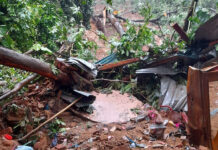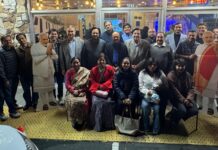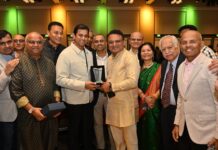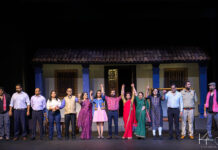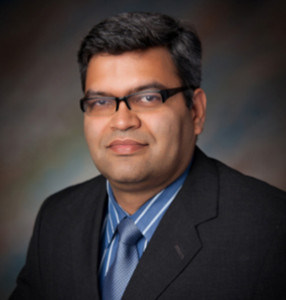
DETROIT, MI: What Dinesh Vyas, an MD and assistant professor of surgery in the College of Human Medicine MI, experienced one night during his emergency department visit to India last February was quite revealing but still tragically common.
During the visit, he volunteered to spend two nights on call in a hospital’s emergency room. Seventeen injured people arrived from two auto accidents. It had taken almost two and a half hours for them to reach the hospital and during that time they had received no medical care. As a result, 13 died of their injuries. It was his 14th visit in last six years.
This was not new to Vyas. He grew up in western India, trained as a physician there, and worked in its hospitals. He had seen too many trauma victims die because they did not receive proper care before arriving at the hospital.
“I’ve seen enormous loss of life from trauma,” Vyas said. “I think it’s my duty to do something about it.” While data is hard to come by, he estimated that 1000 people needlessly die daily from injuries in India. With proper pre-hospital care, 80 percent could be saved, he said.
“In trauma, the first hour – the so-called golden hour – is critical,” Vyas said. In India, there was no standard of emergency care. India is in the same phase as the US was in 1980 as regards to emergency medical care. And there are better cars that are responsible for worse accidents than cars in 1980.
If first responders – including police, paramedics, firefighters, security guards, ambulance drivers, even taxi drivers and others – could be trained to properly care for injured patients before they arrive at the hospital, thousands of lives could be saved each year, he reasoned. And those who survived could have better quality of life by avoiding lifelong disabilities.
“I strongly felt it is imperative training as many people as possible,” Vyas said. “It took me a while to figure out how to take it forward.”
Eight or so years ago, he began designing a program with his own funds. While other American medical schools offer lectures in India, Vyas decided his program, to be effective, would have to be more hands-on using the best simulation for state-of-the-art training (better than training in any part for the world, in many respects), and it must be delivered in the language of the first responders. This was a monumental task considering the hundreds of dialects spoken in India. Video recorded feedback was arranged and necessary tools provided for the first responder to deliver.
He developed a two-day course called the Pre-hospital Trauma Care Training Program which included videos, slide presentations, a manual and emergency medical care kits. In August, he and medical student Apoorva Aekka traveled to Jodhpur in western India. At the All India Institute of Medical Sciences, he first trained the medical school’s deans and professors on how to teach the course.
After that, he and his new recruits began training the first responders.
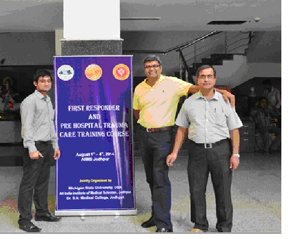
From Laerdal, a manufacturer of medical equipment based in Norway, he obtained a computerized manikin that breathes, bleeds, reacts to treatment and even dies when it receives improper care.
The students practiced checking the manikin’s vital signs, opened its airway, inserted intravenous lines, applied tourniquets, immobilized its spine and learned other basic life-saving skills. The first day, he trained a dozen firefighters, police offices, nurses and ambulance drivers.
As word got out, more first responders showed up and asked to be trained. By the end of his visit, Vyas estimated 70 first responders had been trained.
Before leaving India, he received a call from one of his trainees, who said he had helped care for eight people, including three critically injured in an auto accident. All eight had survived.
“Now I’m getting calls from five big institutions wanting to start a program there,” Vyas said. “I don’t want to turn people away.” Vyas is in touch with their counterparts in India through teleconferencing, and he plans many return visits to conduct more training.” I promised them I will be there within three to six months,” he said.
His goal is to train 5,000 first responders the first year and for the program to grow exponentially, as the knowledge of proper emergency care spreads from trainee to trainee. Eventually, he’d like to introduce the program to other developing countries, including Nepal, Malawi, Sri Lanka, Peru and others.
“What we have to do is figure out how we can branch out and how we can collaborate” Vyas said. “I think it has to be a national or international movement to get it going.”
Although Michigan State University covered the cost of his travel to India, Vyas paid most of the additional expense – $15,000 to $20,000 – himself. He is applying for grants, which he hopes will cover the cost of expanding the program. “A lot of people die who shouldn’t die,” he said. “I want to save them, if I can.”
This lone warrior would make a difference, many agree.
In a talk to this paper, Dr Vyas said that he plans opening two training centers in the country – one in Jaipur and the other in Himachal Pradesh. “This is just a start. I would want to have two such centers in all major cities in India that would help trauma and accident victims greatly,” he said.
Ashok Jain & Ramesh S
